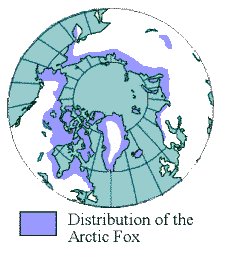 Arctic Fox - Alopex lagopus
Arctic Fox - Alopex lagopusThe arctic fox is distributed throughout the arctic circle along the coasts of North America, Europe and Asia. It can be found amongst the arctic archipelago up to Ellesmere Island, the coasts of Greenland, and throughout Iceland. Tracks have been found as far north as 88N latitude. An isolated population also exists in Mongolia. Its preferred habitat ranges from arctic and alpine tundra to ice covered seas.
During its migrations, the arctic fox undertakes some of the most incredible overland journeys of any land animal. In ´Mammals in North America´, Robert E. Wrigely documented several such treks. In one case, an individual traveled 1000km south from Hudson´s Bay, nearly to the North Dakota border through Manitoba, and back again. In another example, a specimen was found 2000km south of its normal range near Komsomol´sk along the Amur river in eastern Siberia. Finally, he cites an instance where a fox that escaped near Ottawa, Ontario was found two years later, 1100km to the northwest. No terrain seems to hinder these animals in their wanderings. Individuals have been known to travel up to 800km onto the ice cap, and foxes have drifted on ice flows as far south as Nova Scotia. These journeys are even more incredible when one remembers that they are accomplished by an animal no bigger than a house cat. The motivation behind the arctic fox´s movements is its search for food. When food is readily available, a fox may establish a home territory between 860 and 6000ha in size.
| Table of Contents |